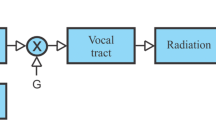Abstract
In current speech technology, linear prediction dominates. The linear vocal tract model is well justified biomechanically, and linear prediction is a simple and well understood signal processing task. However, it has been established that, in voiced sounds, the vocal folds exhibit a high degree of nonlinearity. Hence there exists the need for an approach to modelling the behaviour of the vocal folds. This paper presents a simple, nonlinear, biophysical vocal fold model. A complementary discrete model is derived that reflects accurately the energy dynamics in the continuous model. This model can be implemented easily on standard digital signal processing hardware, and it is formulated in such a way that a simple form of nonlinear prediction can be carried out on vocal fold signals. This model could be of utility in many speech technological applications where low computational complexity synthesis and analysis of vocal fold dynamics is required.
Preview
Unable to display preview. Download preview PDF.
Similar content being viewed by others
References
Markel, J.D., Gray, A.H.: Linear prediction of speech. Springer, Heidelberg (1976)
Proakis, J.G., Manolakis, D.G.: Digital signal processing: principles, algorithms, and applications. Prentice-Hall, Englewood Cliffs (1996)
Kleijn, K., Paliwal, K.: Speech coding and synthesis. Elsevier Science, Amsterdam (1995)
Story, B.H.: An overview of the physiology, physics and modeling of the sound source for vowels. Acoust. Sci. & Tech. 23 (2002)
Ishizaka, K., Flanagan, J.: Synthesis of voiced sounds from a two-mass model of the vocal cords. ATT Bell System Tech Journal 51(6), 1233–1268 (1972)
Steinecke, I., Herzel, H.: Bifurcations in an asymmetric vocal-fold model. J. Acoust. Soc. Am. 97, 1874–1884 (1995)
Little, M.A., Moroz, I.M., McSharry, P.E., Roberts, S.J.: System for generating a signal representative of vocal fold dynamics. UK patent applied for (2004)
Chan, R.W.: Constitutive characterization of vocal fold viscoelasticity based on a modified arruda-boyce eight-chain model. J. Acoust. Soc. Am. 114, 2458 (2003)
Holmes, J.: Speech synthesis and recognition. Van Nostrand Reinhold, UK (1988)
Marsden, J., West, M.: Discrete mechanics and variational integrators. Acta Numerica, 357–514 (2001)
Mergell, P., Herzel, H.: Bifurcations in 2-mass models of the vocal folds – the role of the vocal tract. In: Speech Production Modeling 1996, pp. 189–192 (1996)
Lawson, C., Hanson, R.: Solving least square problems. Prentice-Hall, Englewood Cliffs (1974)
Author information
Authors and Affiliations
Editor information
Editors and Affiliations
Rights and permissions
Copyright information
© 2006 Springer-Verlag Berlin Heidelberg
About this paper
Cite this paper
Little, M., McSharry, P., Moroz, I., Roberts, S. (2006). A Simple, Quasi-linear, Discrete Model of Vocal Fold Dynamics. In: Faundez-Zanuy, M., Janer, L., Esposito, A., Satue-Villar, A., Roure, J., Espinosa-Duro, V. (eds) Nonlinear Analyses and Algorithms for Speech Processing. NOLISP 2005. Lecture Notes in Computer Science(), vol 3817. Springer, Berlin, Heidelberg. https://doi.org/10.1007/11613107_31
Download citation
DOI: https://doi.org/10.1007/11613107_31
Publisher Name: Springer, Berlin, Heidelberg
Print ISBN: 978-3-540-31257-4
Online ISBN: 978-3-540-32586-4
eBook Packages: Computer ScienceComputer Science (R0)




